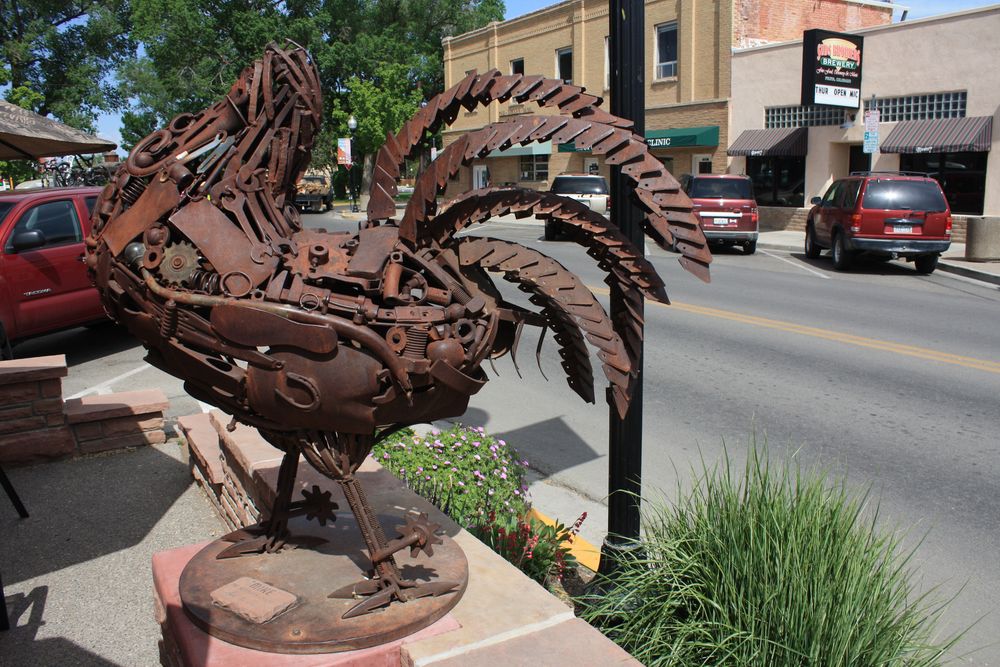Once upon a time in 1945 there was a couple who owned a farm in Colorado. Lloyd Olsen would spend afternoons chopping off chicken heads, while his wife Clara would look over their cleaning. The two-person assembly line produced the same results everyday: some 50-60 chickens readied and delivered to the meat market. But on 10 September, normalcy of the routine broke when despite being beheaded by Lloyd, a chicken refused to die.
As related by Troy Waters, the couple's great-grandson, the chicken stood up and began walking about the lot of dead chickens. As surprised as they were, Lloyd and Clara decided to place it in an apple box on the back porch, unsure of what they would do about it. Little did they know that the fowl would not die for the next 18 months.

As days passed and the bird continued to function, it was named Mike, or Miracle Mike the headless chicken. Word spread like wildfire, and soon Lloyd was cashing in some extra income off bets and shows. The local newspaper was soon interviewing Olsen and reporters were flying into their small town of Fruita for a snapshot of the miraculous bird. One of them suggested the couple put the chicken up for a sideshow circuit. At its beginning, Mike was taken to the University of Utah and subjected to a series of tests. Scientists purportedly beheaded countless other chickens, but none other survived like Mike. Soon, the headless chicken was crossing the road to meet its followers. Nationwide shows were affording its owners new pickup trucks and whatnot, to say nothing of the fame they garnered alongside. As the duo toured the United States with sideshow promoter Hope Wade, Clara religiously documented their exploits in a scrapbook that remains preserved till date.

Feeding Mike with a dropper.
At the age of five and a half months, Mike weighed a healthy three and a half pounds. After beheading, it was fed food through a dropper. The Olsens cleared the mucus from its throat using a syringe to prevent choking. But how was a headless chicken able to survive and move around without a brain? Over the years, research has suggested that most of Mike’s brain remained untouched despite the blow. This could be possible because a majority of a chicken’s brain rests at the back behind the eyes, and not in the frontal part of its head. Normally, beheading cuts the brain off from the rest of the body, and leads to incessant bleeding. The most activity a chicken can manage is running around in a frenzy for—some 15 minutes after—due to a residual supply of oxygen to the spinal nerves. However in Miracle Mike’s case, fate and timing twisted physiology into a bizarre form. Not only Mike survived the beheading, he was able to retain almost 80 percent of the brain and almost everything that controls the chicken's body, including heart rate, breathing, hunger and digestion. It was also possible that a blood clot that formed at the exact moment of the cut prevented the rooster from bleeding to death. In addition, birds possess a secondary balance organ in the pelvic region, the lumbosacral organ, which controls walking locomotion. This explained how a headless chicken was able to walk and balance despite losing much of the cranial vestibular system.

Serendipity comes in strange ways, and often leaves us wanting for more. Doubtlessly, Lloyd tried time and again to recreate the hatchet blow on various other chickens. Awestruck followers and curious neighbours did too. But only Mike went down in history as an enigma. Its imminent death came simply though, thanks to human error. One night, the Olsens woke up to the sound of a choking bird. Looking for the syringe to clean out Mike’s passages, they realised that they had left the tool at the sideshow. Unable to clean out the mucus, the couple watched Miracle Mike choke to death after 18 months of a headless yet eventful life. Years later, the life of the rooster is still celebrated in Fruita, where a sculpture commemorates its headlessness.

A metal sculpture in Mike's image in Fruita. Photo: David Herrera/Flickr
References
# BBC
# The Gazette












Comments
Post a Comment